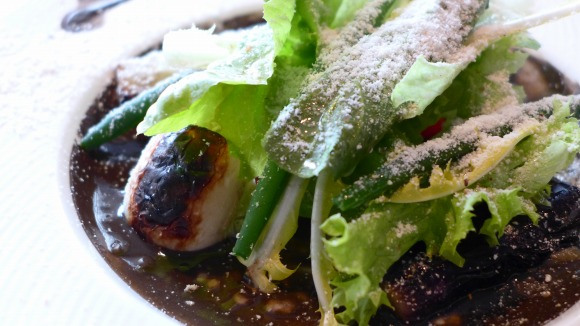
There is a chic French restaurant in Tokyo’s Gotanda district known to those in-the-know. It’s called Ne Quittez Pas, and it is famous for using high-quality seafood and produce from Kanagawa’s Misaki region. However, they’ve just unveiled a new full-course menu created around a rather peculiar ingredient: actual dirt. Of course, we had to check it out.
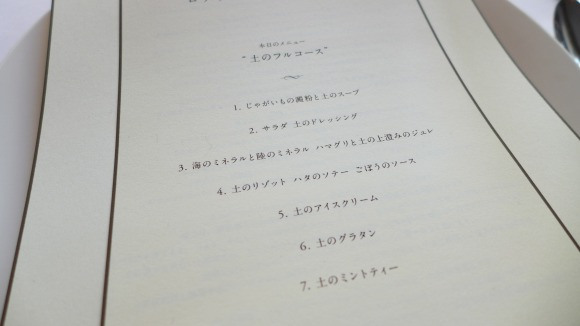
The Dirt Course
Perhaps having dirt still clinging to a vegetable is a sign of its freshness, but actually eating that dirt isn’t exactly appealing. But the chef at this restaurant once won a TV cooking show battle with a sauce made with dirt, so surely there must be something to this cuisine, common sense aside. But what exactly could we expect? Sipping a lovely glass of pink watermelon champagne, we waited with anticipation.
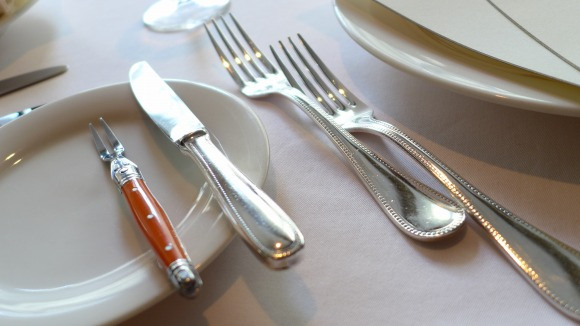
Shovel not pictured.
The first course: a potato starch and dirt soup. It arrived in a shot glass looking so dark brown, it was almost black. It definitely looked like it had dirt in it. A slice of black truffle was balanced on top, and the staff instructed us to take a bite of it and then try the soup. So we did… and it was divine! There wasn’t a dirty flavor at all. Instead, this simple soup went down smoothly with just a hint of potato flavor.
The rim of the shot glass was dusted with salt like a margarita, so after the initial saltiness, your mouth filled with the mild flavor of the soup. The dish impressed us more with the chef’s skill than with the potential of the unusual ingredient, though.
Next up: salad with dirt dressing. As simply as I can describe it, this dish featured fresh vegetables like eggplant, tomato and turnips grilled and served with a dressing made from dirt and a fine powder made from ground popcorn. Here too the surprise wasn’t the dirt, but the deliciousness of the vegetables. The tomatoes had the perfect balance of sweetness and acidity, and the eggplant hadn’t taken on any bitterness from the grilling.
I’d come here to try a dirt course, but the food tasted so little of the earthiness I was expecting that I’d kind of forgotten about that ingredient. According to the staff, the dirt used is a special black soil from Kanuma, Tochigi Prefecture. It’s strictly tested for safety and purity to be used in food, but so far I thought I hadn’t been able to notice a “dirt” flavor in the meal.
Next up: “minerals of the sea and minerals of the land,” an aspic made with oriental clams and the top layer of sediment, and a dirt risotto with sauteed sea bass and burdock root. With these dishes too, there wasn’t a dirt flavor. I had to wonder what had happened to the characteristic yeasty smell of soil.
For dessert, there was dirt ice cream and a dirt gratin. Perhaps because of the mildness of the food, the complex sweetness of these items was all the richer. And finally, there was a refreshing dirt mint tea to cleanse the palate, though it does seem strange to describe something made with dirt as cleansing or refreshing. It looked like muddy water (sorry, but it’s true), but the minty taste was bracing.
With its mild cuisine, sweet desserts and refreshing tea, the course had the flavor and modulation you would expect from Ne Quittez Pas’s talented chef. As to why the meal didn’t taste at all of dirt, that is likely due to the dirt itself, which is supplied by a company called Protoleaf. Using coffee grinds and palm fiber, which were previously just thrown away, the company has created a novel and eco-friendly compost.
The chef also credits Protoleaf’s compost for making his dirt course possible, so it seems that not all dirt is created equal.
By the way, if you would like to try Ne Quittez Pas’s dirt course for yourself, reservations must be made at least one week in advance and the cost is about 10,000 yen per person (about US$110).
For more information and directions to Ne Quittez Pas, check their English website here.
[ Read in Japanese ]

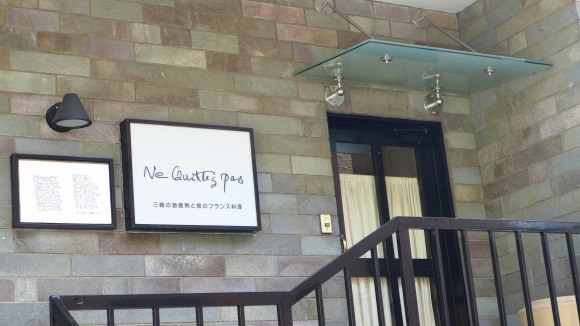
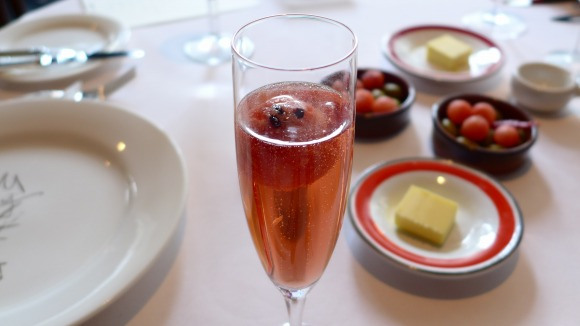

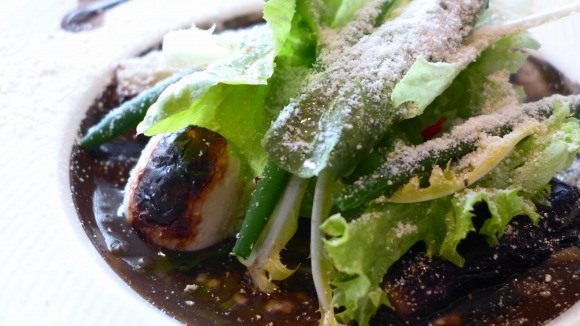
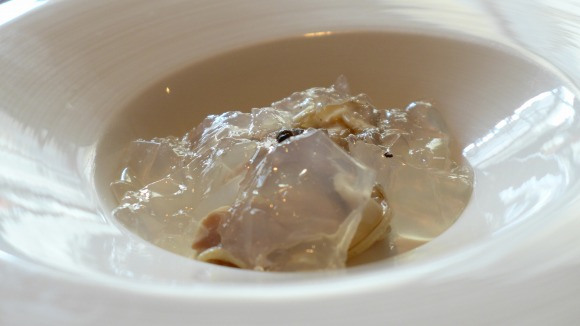

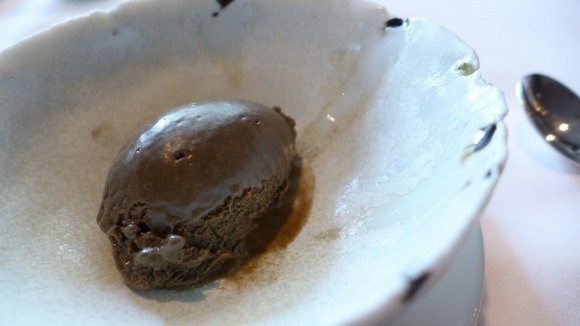
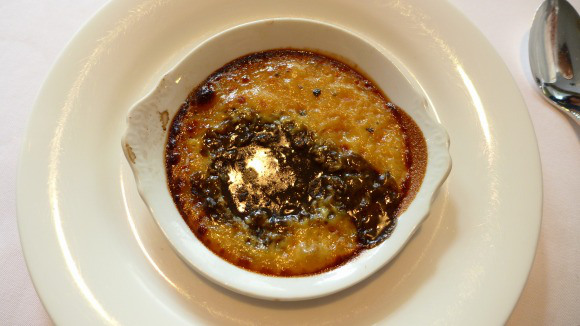
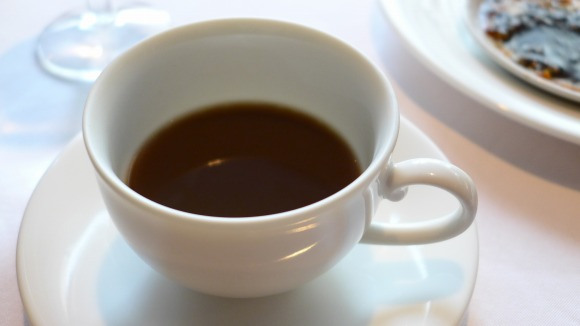
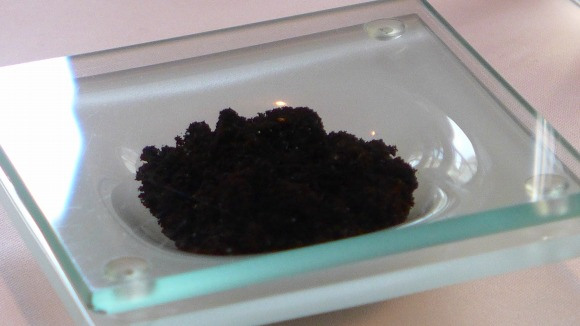
 Get Your Delicious Indigenous Grub on at Tokyo’s Only Ainu Restaurant
Get Your Delicious Indigenous Grub on at Tokyo’s Only Ainu Restaurant Matcha buffet in Osaka gets ready for fall by adding delicious autumn-inspired eats to the lineup
Matcha buffet in Osaka gets ready for fall by adding delicious autumn-inspired eats to the lineup We indulge in all-you-can-eat “Navy Curry”, discover the buffet of our dreams
We indulge in all-you-can-eat “Navy Curry”, discover the buffet of our dreams Tokyo has an exclusive curry restaurant for members only to eat in, and we’ve tried its food
Tokyo has an exclusive curry restaurant for members only to eat in, and we’ve tried its food Could this be the secret to get Americans to actually like natto (Japanese fermented soy beans)?
Could this be the secret to get Americans to actually like natto (Japanese fermented soy beans)? Japanese beef bowl chain Sukiya’s 2026 Smile Box lucky bag basically pays for itself
Japanese beef bowl chain Sukiya’s 2026 Smile Box lucky bag basically pays for itself Majority of Japanese mayors say foreign residents are essential but most see good and bad effects
Majority of Japanese mayors say foreign residents are essential but most see good and bad effects We revisited Sweets Paradise after a decade to see if Japan’s dessert buffet still delivers
We revisited Sweets Paradise after a decade to see if Japan’s dessert buffet still delivers 7-Eleven Japan starts new temporary luggage storage service in over 300 branches
7-Eleven Japan starts new temporary luggage storage service in over 300 branches Japanese department store rooftop is a secret oasis where you can escape the crowds in Tokyo
Japanese department store rooftop is a secret oasis where you can escape the crowds in Tokyo Starbucks teams up with 166-year-old Kyoto doll maker for Year of the Horse decorations【Photos】
Starbucks teams up with 166-year-old Kyoto doll maker for Year of the Horse decorations【Photos】 Record number of foreign children in Japan need help understanding Japanese in school
Record number of foreign children in Japan need help understanding Japanese in school Demon Slayer’s Mugen Train is now ready to be your personal home sushi train too【Photos】
Demon Slayer’s Mugen Train is now ready to be your personal home sushi train too【Photos】 Exhibit featuring cutting-edge smell technology held at Tokyo Skytree
Exhibit featuring cutting-edge smell technology held at Tokyo Skytree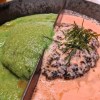 Hamburg and Hamburg Shibuya: A Japanese restaurant you need to put on your Tokyo itinerary
Hamburg and Hamburg Shibuya: A Japanese restaurant you need to put on your Tokyo itinerary Starbucks Japan ready to get Year of the Horse started with adorable drinkware and plushies【Pics】
Starbucks Japan ready to get Year of the Horse started with adorable drinkware and plushies【Pics】 Hayao Miyazaki says Happy New Year to Studio Ghibli fans with new art for Year of the Horse
Hayao Miyazaki says Happy New Year to Studio Ghibli fans with new art for Year of the Horse We found possibly the quietest Japanese-style hotel in Tokyo’s bustling Shinjuku district
We found possibly the quietest Japanese-style hotel in Tokyo’s bustling Shinjuku district Cup Noodle tries an authentic Jiro-style ramen, but something’s not quite right
Cup Noodle tries an authentic Jiro-style ramen, but something’s not quite right The best Starbucks Japan Frappuccinos we want to drink again in 2026
The best Starbucks Japan Frappuccinos we want to drink again in 2026 That time Seiji called JASRAC to ask why he didn’t get paid royalties for his song being on TV
That time Seiji called JASRAC to ask why he didn’t get paid royalties for his song being on TV Japan’s oldest largetooth sawfish in captivity back on display in Mie Prefecture
Japan’s oldest largetooth sawfish in captivity back on display in Mie Prefecture Pizza Hut Japan’s hot lucky bags are perfect for a New Year’s pizza party
Pizza Hut Japan’s hot lucky bags are perfect for a New Year’s pizza party Disillusionment at Tsukiji’s tourist-target prices led us to a great ramen restaurant in Tokyo
Disillusionment at Tsukiji’s tourist-target prices led us to a great ramen restaurant in Tokyo Tokyo considering law requiring more trash cans following litter increase in heavily touristed area
Tokyo considering law requiring more trash cans following litter increase in heavily touristed area Tokyo’s Tsukiji sushi neighborhood asks tour groups to stay away for the rest of the month
Tokyo’s Tsukiji sushi neighborhood asks tour groups to stay away for the rest of the month Tokyo event lets you travel back in time, for free, to celebrate 100 years since Showa era start
Tokyo event lets you travel back in time, for free, to celebrate 100 years since Showa era start Japan may add Japanese language proficiency, lifestyle classes to permanent foreign resident requirements
Japan may add Japanese language proficiency, lifestyle classes to permanent foreign resident requirements Sanrio theme park in Japan announces plans to expand into a Sanrio resort
Sanrio theme park in Japan announces plans to expand into a Sanrio resort Stamina-destroying “Paralysis Noodles” are Tokyo’s newest over-the-top ramen innovation
Stamina-destroying “Paralysis Noodles” are Tokyo’s newest over-the-top ramen innovation Survey asks foreign tourists what bothered them in Japan, more than half gave same answer
Survey asks foreign tourists what bothered them in Japan, more than half gave same answer Japan’s human washing machines will go on sale to general public, demos to be held in Tokyo
Japan’s human washing machines will go on sale to general public, demos to be held in Tokyo Japan’s deadliest food claims more victims, but why do people keep eating it for New Year’s?
Japan’s deadliest food claims more victims, but why do people keep eating it for New Year’s? We deeply regret going into this tunnel on our walk in the mountains of Japan
We deeply regret going into this tunnel on our walk in the mountains of Japan Studio Ghibli releases Kodama forest spirits from Princess Mononoke to light up your home
Studio Ghibli releases Kodama forest spirits from Princess Mononoke to light up your home Major Japanese hotel chain says reservations via overseas booking sites may not be valid
Major Japanese hotel chain says reservations via overseas booking sites may not be valid Put sesame oil in your coffee? Japanese maker says it’s the best way to start your day【Taste test】
Put sesame oil in your coffee? Japanese maker says it’s the best way to start your day【Taste test】 No more using real katana for tourism activities, Japan’s National Police Agency says
No more using real katana for tourism activities, Japan’s National Police Agency says Starbucks Japan reveals new sakura drinkware collection, inspired by evening cherry blossoms
Starbucks Japan reveals new sakura drinkware collection, inspired by evening cherry blossoms Updated cherry blossom forecast shows extra-long sakura season for Japan this year
Updated cherry blossom forecast shows extra-long sakura season for Japan this year We try ramen from a can on the backstreets of Tokyo【Taste Test】
We try ramen from a can on the backstreets of Tokyo【Taste Test】 Koto is a local favorite in Iruma, Saitama, for its large food portions, so we check it out
Koto is a local favorite in Iruma, Saitama, for its large food portions, so we check it out We use the Seishun 18 Ticket to travel from Japan to Korea by ferry
We use the Seishun 18 Ticket to travel from Japan to Korea by ferry We try eating insects — they don’t taste like chicken
We try eating insects — they don’t taste like chicken
Leave a Reply